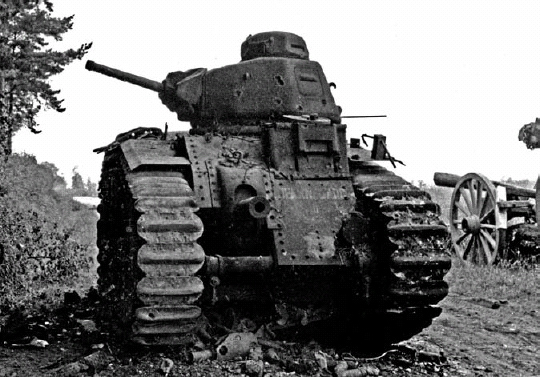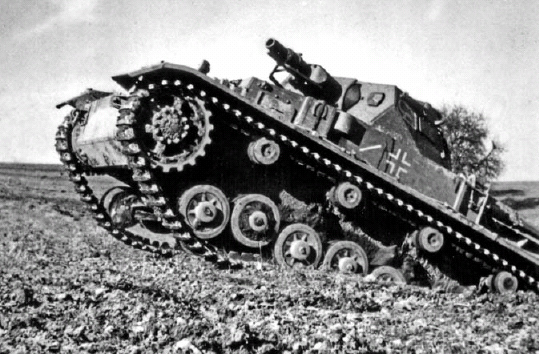
The Battle of France in May–June 1940 was the first military campaign to see large-scale tank-vs.-tank fighting. Only a handful of tank-vs.-tank clashes had occurred in World War I, and they were rare during both the Spanish Civil War and the Poland campaign of 1939 as well. The Battle of France was also the first campaign to see the use of armored divisions by both sides. This book examines the clashes between two of the best tanks of the 1940 French campaign, the French Char B1 bis and the German PzKpfw IV.
Tanks had emerged from World War I as an important, but flawed, innovation. Advances in firepower such as the machine gun and long-range artillery were better used as defensive weapons and led to the stagnation and horrors of trench warfare in 1914–18. The early tanks were a reincarnation of medieval siege engines, fragile but powerful weapons capable of cracking open a fortified trench line. The big question in the interwar years was whether tanks could help restore the battlefield balance by challenging the murderous firepower of the defense with enough mobility and armored protection to sustain offensive missions. The answer was by no means clear because early tanks were not durable enough to conduct operations for much more than a day or two before breaking down, becoming trapped in trenches, or exhausting their fuel supply. Tank technology improved in the 1920s and early 1930s, but the French Army remained saddled with its rusting Great War tanks. Their dismal automotive performance poisoned the attitudes of many French commanders to the potential of tanks beyond their limited role as infantry support weapons.
In Germany, the Kaiser’s army had been unenthusiastic about tanks in World War I and had the smallest armored force of the Great Powers. The Versailles treaty banned tanks from the postwar Reichswehr but the ban had perverse consequences. Germany was not burdened with archaic tanks that might discourage army interest in mechanization. By explicitly banning tanks, the Allies merely convinced the Germans that the forbidden must be very desirable. Even relatively conservative German officers saw a necessity to acquire tanks as soon as possible to assuage this affront to the German Army’s honor. Between the end of the war in 1918 and Hitler’s rise to power in 1933, the German attitude towards tanks completely reversed, and the German Army began to emerge as an enthusiastic proponent of armored warfare.
Some far-sighted German officers saw the tank as more than a mere technical innovation, but as the seed for a revolution in warfare, shifting the balance back to the offensive in place of the defensive stagnation of World War I. The panzers were the steel core of a more elaborate effort at combined-arms mechanization and the panzer divisions included a balanced mix of tanks, mechanized infantry, and motorized artillery. The panzer divisions saw their vindication in Poland in September 1939, but it was one thing to defeat the outnumbered Poles and another thing to take on the vaunted French Army.
The French Army regarded the tank as a vital element in its doctrine of methodical battle. French doctrine was preoccupied with the lessons of World War I, convinced that the infantry needed a steel backbone of tank support to survive against the deadly firepower of the modern battlefield. The majority of French tanks were committed to the mission of infantry accompaniment. At the same time, the French recognized the need for mobile forces to carry out other missions. The tank offered a mechanized alternative to the horse for the traditional cavalry missions of reconnaissance and exploitation. As a result, the French devoted about a quarter of their tank force to this mission. These light mechanized divisions (DLM) were the closest French equivalent to the German panzer divisions, but they were far fewer in number in 1940: only three divisions compared to ten German panzer divisions. The French also saw the need for a heavily armored shock force to support the advance of the infantry, but there was no consensus until the German demonstration of panzer divisions in Poland in 1939. In early 1940, the French Army began consolidating their new Char B1 bis tank battalions into their own embryonic armored divisions (DCr). The French armored divisions were much smaller than their German counterparts and were not a well-balanced combined arms force. They were especially weak in motorized infantry. However, their main flaw was not organizational but chronological. They were created too late to undergo proper training; only two were fully organized by May 1940, and they lacked the practical experience of their German opponents.

Like the Tiger tank later in the war, in 1940 the Char B1 bis was largely invulnerable to most enemy anti-tank weapons of the time. “Jeanne d’Arc” (no. 425) of the 1/47e BCC attacked a German bridgehead at Doudelainville, southwest of Abbeville, in the late afternoon of May 28, 1940. Under the command of Capt. Dirand, the tank destroyed two German 37mm anti-tank guns with its 75mm gun, but had that gun put out of action when a round struck inside the 75mm barrel. It continued its attack using its machine guns. Near Croisettes, it came under intense fire from numerous weapons of various calibers but the rounds bounced off its thick armor. It crushed several German guns under its tracks. It was finally hit on the left side by a heavy caliber gun, probably an 88mm, and put out of action. It received over 90 hits in two hours of fighting and destroyed about a dozen guns and two armored cars. (Patton Museum)

The PzKpfw IV was weakly armored and its firepower was inadequate against contemporary French tanks. However, it had a reliable and robust design that would become the workhorse of the Wehrmacht later in the war after being modernized and improved. This is a PzKpfw IV Ausf. D of Pz.Rgt.9, 10.Panzer Division on exercise in April 1940 at the Baumholder training grounds. (NARA)
The German Army in 1940 enjoyed significant tactical and organizational advantages over their French opponents, particularly in the areas of training and experience. However, the French Army held a slight edge in the number of tanks, and in many cases had better tanks. The Char B1 bis tank was the most powerful of its era. Not only was it armed with an impressive combination of both a 75mm gun and an excellent 47mm gun, but its thick armor was nearly impervious to German tank and anti-tank guns. The Char B1 bis’ main weakness was an awkward design that can be traced back to its premature genesis in 1920. The PzKpfw IV was a robust and sound design, but like most German tanks of the era, it was weakly armored since the Wehrmacht favored speed and surprise over firepower and defense. It was designed to support the PzKpfw III main battle tank with high-explosive firepower, so its short 75mm gun was not effective in tank fighting. In spite of the technological imbalance in favor of the French, the German panzer units prevailed in most of the major tank engagements of the campaign.
The focus of this book is the combat duel at Stonne which pitted the PzKpfw IV tanks of Pz.Rgt.8, 10.Panzer Division against the two Char B1 bis battalions of the 3e DCr. The battle of Stonne was compared by one German officer to Stalingrad and Monte Cassino in its ferocity; it was grimly called the “Verdun of 1940” by German and French veterans alike.